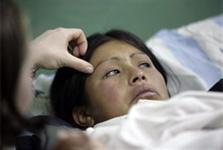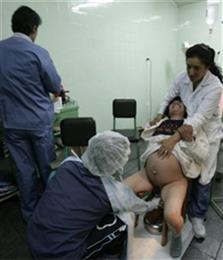|

Blending still images and audio and packaging them in a form which looks almost like video - multimedia presentation - is a fast-growing practice on the internet.
No look at the future would be complete without considering this new way of presenting images online which is why the work of Mariana Bazo of Reuters is featured here.
Using more than one medium means photojournalists must - to some extent - become multi-tasking when capturing material and the first multi-media commission is always going to be a something of a challenge.
Mariana, from the Peruvian capital Lima, spent several days in a clinic in the Andean city of Cuzco in May 2008 recording births with her Canon 5D and an Olympus DS30 recorder.
You can view the two results by clicking on images in right-hand column of this page.
As with many ordinary commissions, the first thing to do was to get permission to shoot.
Says Mariana: “I had to obtain permission not just of the director and doctors but the mothers too. But they were very nice and let me shoot. I am a woman and mother and the mothers there would say ‘Do you have a child? Good. You will understand.’
Actually the mothers looked on me as extra company during the pain of birth. They asked me questions, made comments, talked to me. Sometimes, I held their hands.
During one delivery, there was a blackout and I helped by providing a little light from my Blackberry and the screen on the back of my Canon 5D but I couldn’t take pictures then”.
Continues Mariana: “This was different from many of the stories I usually cover for Reuters. I had several days instead of having to rush to file my pictures and I had to capture all the sounds and do the interviews. The only difficulty I had was remembering to move the recorder I was using out of shot.
I am looking forward to using multi-media again. It opens new ways of showing pictures – it’s wonderful to see the final project and that forty of my pictures were used in a story for Reuters. Reuters thought it was a good project – and experiment. There was plenty of feedback from a different audience and I wrote about the experience on the Reuters blog.”
Once the material had been collected by Mariana, it was put together by a Reuters’ team.
Say Reuters: “Mariana sent the elements to our online desk in Toronto where Julie Gordon, who has a background in radio and is fluent in Spanish, edited the audio and transcribed the material.
The edited audio was then sent over to Corinne Perkins who edited the images and sequenced them with the audio to create the final product.
Audacity was used to edit the audio and Soundslides was used to put all the elements together.
The use of audio allowed the women to tell their individual stories and enabled the project to follow each of the women separately rather than lump them together in a single slideshow. Audio also allowed the viewer to use another sense when experiencing the story.
Enabling the viewer to hear the natural sounds allows them to be closer to the location and feel the women's pain.
Unfortunately we don't have any metrics to measure how many viewed the slideshow but judging by the feedback on the photographer's blog entry, the presentation affected many readers and there was an outpouring of appreciation at the story being told.”
|
|

Jenny’s story

Birthing – A Vertical View
|
|